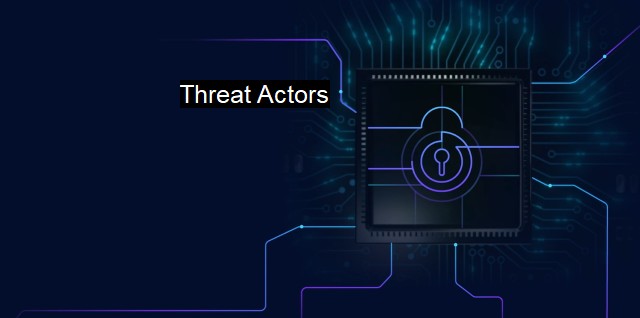What are Threat Actors?
Understanding Threat Actors in Cybersecurity and Antivirus: Types, Motivations, and Blurred Lines in Today’s Landscape
Threat actors, in the context of cybersecurity and antivirus protection, are individuals or entities responsible for incidents that negatively impact, or have the potential to unfavorably influence, the security of information systems and networks. They pose a constant challenge to the norms of digital safety, pushing the architecture of cybersecurity to continue evolving to effectively manage the ever-present backdrop of cyber threats.The landscape of cyber threats is diverse, with threat actors varying vastly in their capabilities, intent, and the methodologies implemented. On one end of the spectrum are individual hackers, often jet-setting amateurs or sometimes disgruntled employees with limited resources and relatively simplistic techniques. They may employ methods such as password cracking, worms, or viral attacks.
In stark contrast on the other end of the spectrum are highly sophisticated and resource-laden entities like organized criminal groups and nation-states. These advanced persistent threats use an array of refined techniques, ranging from spear-phishing, espionage, denial of services (DoS), Distributed denial of services (DDoS), or zero-day attacks, stealthily intruding, and persistently violating target information systems.
Crime syndicates utilize the allure of quick monetary gains as their core motivation and use ransomware, fraud, data theft and trade these stolen data on the dark web that in itself is another landscape of cyber threats. Correlated to them, albeit non-monetary and more information centric, insider threats occur when individuals within an organization consciously or inadvertently undermine its cybersecurity. Irrespective of their motivations, they stand uniquely capable of causing extensive damage due to their innate knowledge of the organizations underside and how its security layers function.
Nation/state-sponsored groups have an added layer of complexity. Their intents predominantly center around gaining political, economic, or military advantages. Capitalizing on their enormous resources, they fund continuous research to exploit cyber vulnerabilities on a grand scale effectively.
A significant risk associated with cyber threats is that of the 'double extortion' ransomware tactic where threat actors increase pressure on victims to pay ransoms by threatening to leak sensitive data asymmetrically. Similarly, 'ransomware as a service (RaaS)' model where ransomware services are sold in exchange for a fee or share of proceeds, thus attracting a larger pool of less-skilled threat actors, continuously fuels the evolution of cybersecurity threats.
While understanding threat actors and the nature of threats posed is crucial, it is equally important to note the growing sophisticated innovations in cyber defense. Use of antivirus software guarding against malware, advanced threat intelligence services that collect information about existing and potential cyber threats, or using deception technology that diverts attackers away from valuable assets- countermeasures have adapted and evolved along with cyber threats. Regular security audits, effective disaster recovery plans, the rapid deployment of patches and upgrades, endpoint protection, firewalls or intrusion detection systems, artificial intelligence (AI) and machine learning (ML) technologies in threat detection – these solutions provide a breath of hope in an otherwise daunting digital landscape.
The advent of stricter legislations like the General Data Protection Regulation (GDPR) are indicative of global efforts to establish digital legality and punitive actions against threat actors. these regulatory provisions come with possibilities of evolving geopolitical ramifications slurried with legal complexities, underscoring the need for a global co-operative approach.
Threat actors form the core of the cybersecurity landscape leading the continuum of cyber threats. With motivations ranging from personal thrill, financial gain, socio-political disruptions to warfare strategies, their modus operandi is dynamic and continuously evolving. Similarly, the countermeasures in the form of cybersecurity and antivirus solutions are adapting and innovating. Future developments in the intricate chess game between the two forces will doubtlessly have profound implications to individuals, organizations, nations, and the fundamental building blocks of our interconnected digital world. understanding the modus operandi of these threat actors is the first cognitive step toward countering them.

Threat Actors FAQs
What are threat actors in cybersecurity?
Threat actors are people or groups who engage in activities that threaten the security of digital devices, networks, and data. They may be individuals, criminal organizations, nation-states, or other entities.What motivates threat actors in cyber attacks?
Threat actors may be motivated by financial gain, political or ideological reasons, revenge, or simply the challenge of breaking into a system.How do antivirus programs protect against threat actors?
Antivirus programs use a variety of techniques to detect and block threats from threat actors, including signature-based detection, heuristic analysis, and behavior-based analysis. They also typically provide real-time protection by scanning files and network traffic for signs of malicious activity.What are some common types of threat actors in cybersecurity?
Some common types of threat actors include hackers, who exploit vulnerabilities in systems to gain unauthorized access; insiders, who use their authorized access to carry out attacks; and cybercriminals, who steal data or commit fraud for financial gain.| | A | | | B | | | C | | | D | | | E | | | F | | | G | | | H | | | I | | | J | | | K | | | L | | | M | |
| | N | | | O | | | P | | | Q | | | R | | | S | | | T | | | U | | | V | | | W | | | X | | | Y | | | Z | |
| | 1 | | | 2 | | | 3 | | | 4 | | | 7 | | | 8 | | |||||||